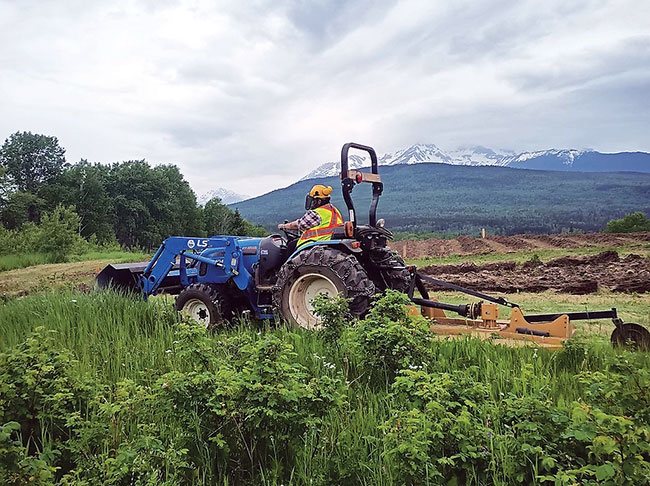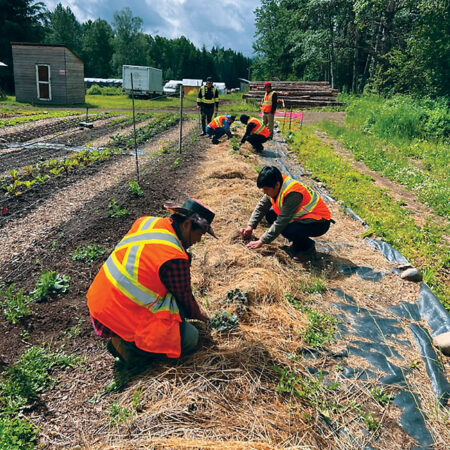
Features
Sustainability
Technology
Tea Creek: Continuing a legacy of regenerative agriculture
Rebuilding regenerative agriculture for a more resilient future.
June 6, 2023 By Kaitlin Packer
 Jacob Beaton is a fan of agritech with a purpose, like improving productivity or profitability.
Photos courtesy of Jacob Beaton, Tea Creek.
Jacob Beaton is a fan of agritech with a purpose, like improving productivity or profitability.
Photos courtesy of Jacob Beaton, Tea Creek. There’s no doubt the pandemic highlighted some major supply chain issues – and remote communities in British Columbia faced more pressure than some. Severe flooding and significant wildfires intensified the problem, further displaying the fragility of food production, sustainability and access to supporting tools. As with many agricultural challenges, Canadians began working together to find a solution.
In 2022, the B.C. Ministry of Agriculture and Food launched the Regenerative Agriculture and Agritech Network (RAAN) advisory group. “We came back to regenerative agriculture and began thinking about how [it] can help,” says Georgina Beyers, director of agritech, innovation and regenerative agriculture with the Ministry of Agriculture and Food.
With 18 group members, including academia, private entities, agritech companies and producers, the RAAN worked together to formulate a strategic framework for regenerative agriculture and agritech in B.C. The goal was to create a strategy for a more resilient food system by adopting more sustainable agricultural practices and utilizing agritech. “We also identified early on in the process there was a really crucial Indigenous perspective we needed to capture in this,” says Beyers. “And that is that pre-colonial Indigenous agriculture is in fact representative of the principles of regenerative agriculture.”
That’s just one reason Jacob Beaton, an Indigenous farmer and owner of Tea Creek in Kitwanga, B.C., is a crucial member of the RAAN advisory group. “This was the one thing I made myself available to do,” he says. “With the hopes that it will lead to better things for Indigenous people and also with the hopes […] that we can see more farmers in B.C., and we can see more regenerative agriculture in B.C.”
With the efforts going into pursuing regenerative agriculture, the big question on everyone’s minds is obvious: What is regenerative agriculture? Beyers says defining it is counterintuitive. “The concept of regenerative is that there are always more things that you can do,” she says. “There are always more improvements that you can do to make the soil healthier, to make the ecosystem healthier, and to environmentally steward the land which you’re utilizing for agricultural production.”
Beaton leaves the definition up to the experts. “The generally accepted definition of regenerative agriculture is that it’s building topsoil instead of depleting it,” he says. His focus is advocating for Indigenous agriculture, which is “about the whole ecosystem, so it includes forests, streams, rivers, oceans, as well as soil.”
He explains Indigenous agriculture is inherently regenerative. In fact, early European explorers and settlers documented the tremendous plant growth that came from Indigenous farming practices. “[Indigenous people] were primarily farmers, and the communities were built around large fields that were then divided up and co-operatively farmed by extended families,” says Beaton. The descriptions of their farming practices include regenerative methods we’re familiar with today: cover crops, heavy mulching and no-till practices.
Building the Tea Creek model
As a modern Indigenous farmer, Beaton had his first full year to experiment with growing different vegetables at the Tea Creek location in 2019. This ended up being good preparation for the events of 2020. “It was born out of the pandemic, really,” he says. “Food systems were interrupted, and people were going hungry and store shelves were empty.” This happened again when the flooding in Abbotsford cut off highways.
Because the food supply was inconsistent in their region in 2020, a local grocery store said they would buy anything Tea Creek produced. “Here’s the crazy thing,” says Beaton. “We way overproduced, so stuff we tried in 2019, the methods were beyond our wildest dreams.” They ended up going door to door within the community, giving away the extra produce – and gifting the produce became their standard practice going forward.
This paved the way for the current model of Tea Creek, established in 2021. “Our vision is healthy, resilient, Indigenous communities built around abundant, local food,” explains Beaton, who says this used to be the reality for Indigenous communities a century ago. “All of that was destroyed over time through intentional policies.”
The goal behind Tea Creek is to restore food sovereignty to Indigenous communities not only by supplying the region with food, but also by educating people in surrounding communities on how to produce their own food. “We had an overwhelming amount of people sign up for training every year since we started,” says Beaton. “Every single year, we’ve received over three times the enrollments as we get funded for and on top of the enrollments, we receive hundreds and hundreds of extra people coming for training and learning experiences at Tea Creek.”
Beaton says supporting this training with sufficient resources is a key opportunity for government entities to put reconciliation into action. “Nobody loses when we increase our local food production,” he says. With the aging population of farmers and even fewer Indigenous farmers, this is an important opportunity for the province. “I have 1,200 [people] in one year coming to my farm, wanting to learn,” says Beaton. “We’re going to introduce thousands of regenerative, local, regional farmers across the province, but we can’t do that in the current environment.”

Tea Creek educates communities on how to produce food.
Recognizing the opportunity at Tea Creek
The farm grows mixed vegetables for now, but the hope is to continue to expand the operation to animals, orchards and berries. “We’re in an amazing climate zone where we can grow anything here,” says Beaton. “Last year, we grew what we call hot crops and cold crops.” Corn, watermelon, cabbage, and potatoes are just a few of the popular foods.
“Biodiversity is the cornerstone,” he says. “It’s absolutely key.” At Tea Creek, Beaton has a healthy forest surrounding the farm, allowing for insects, animals and other plants to be in close proximity. “What we’ve observed is that we haven’t had to use organic or non-organic pesticides because we have so many natural predators coming in and keeping the pests down.” Even though they don’t have deer or bear fencing, Beaton finds the animals like to stay in the forest where there’s already a good supply of food.
Tea Creek’s continued expansion and innovation also involves using the proper technology. “I’m a huge fan of agritech,” says Beaton. “I’m just not a fan of it being done for the sake of just being done; there has to be a purpose where it’s actually making your life easier or more profitable, more productive.” At Tea Creek, he utilizes automated switches and temperature controllers to cut down on labour. Drone-mapping is also part of the training, useful for observing the soil and water, as well as crop planning.
Beyers sees agritech as having a key role in “meeting the goals of regenerative agriculture, climate action, environmental stewardship.” When it’s utilized properly, it can help solve productivity and labour issues in the industry.
Increased resiliency for a better future
For many growers, regenerative agricultural practices are already part of their everyday operation. Increased efforts to be environmental stewards of the land will continue to lead to more resiliency – and greater resiliency will ensure producers’ profitability is less affected by conditions out of their control.
As Beaton says, nobody loses when we promote Indigenous agriculture and the inherently regenerative practices that come with it. “We want to increase biodiversity. We want to steward the land. We want to feed everybody,” says Beaton, “and that’s an unbroken cultural piece that was here before and is still here.”
Print this page